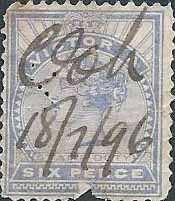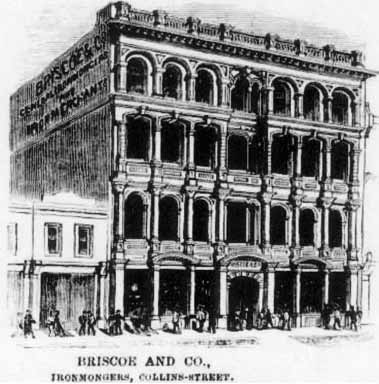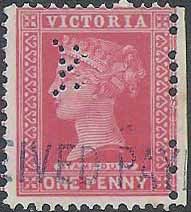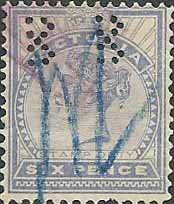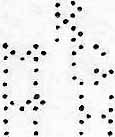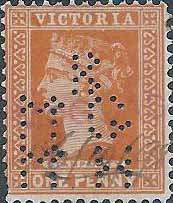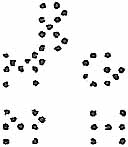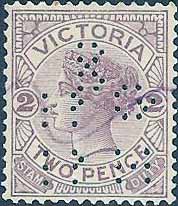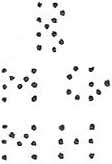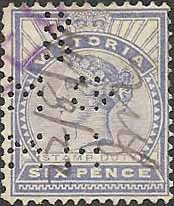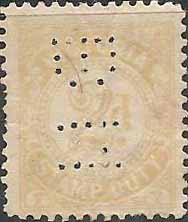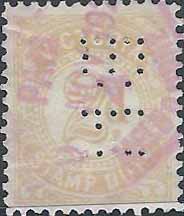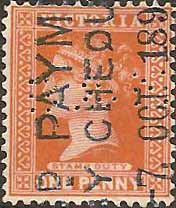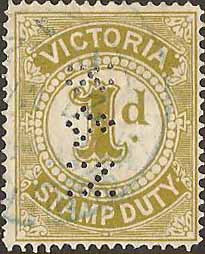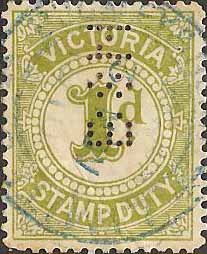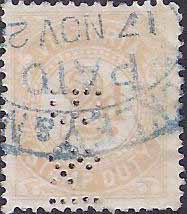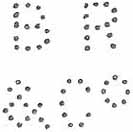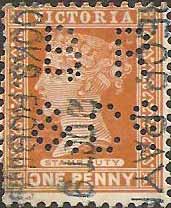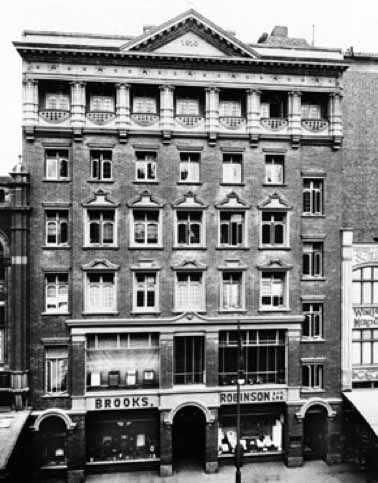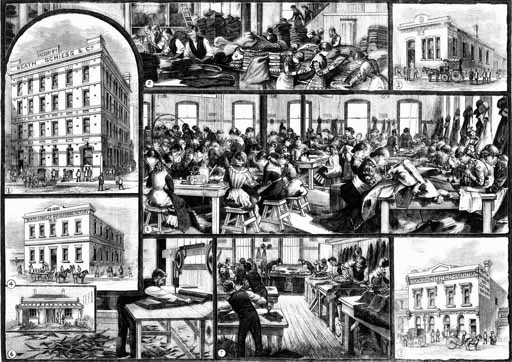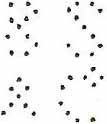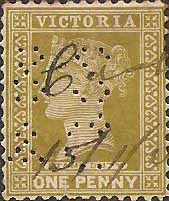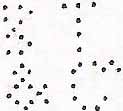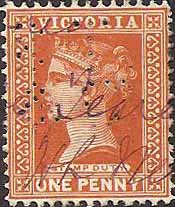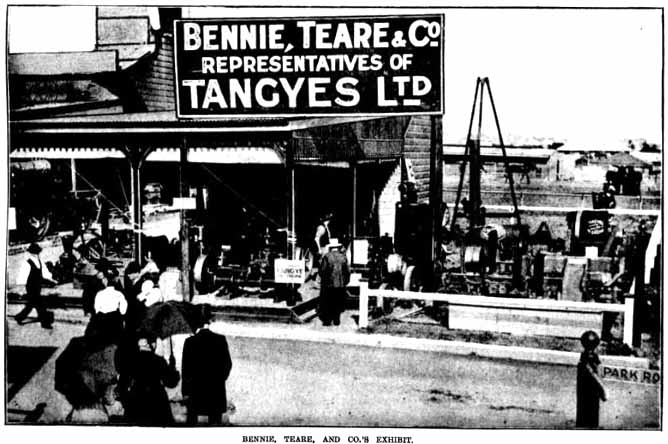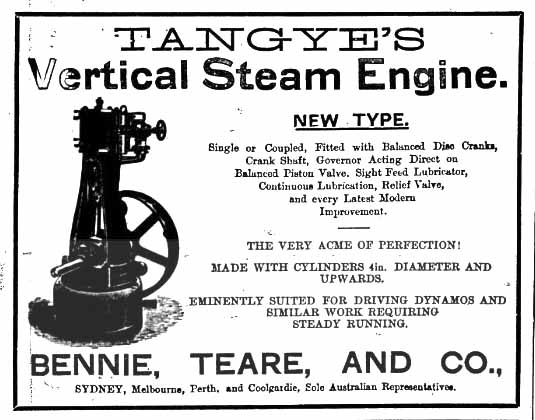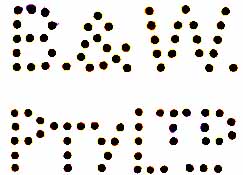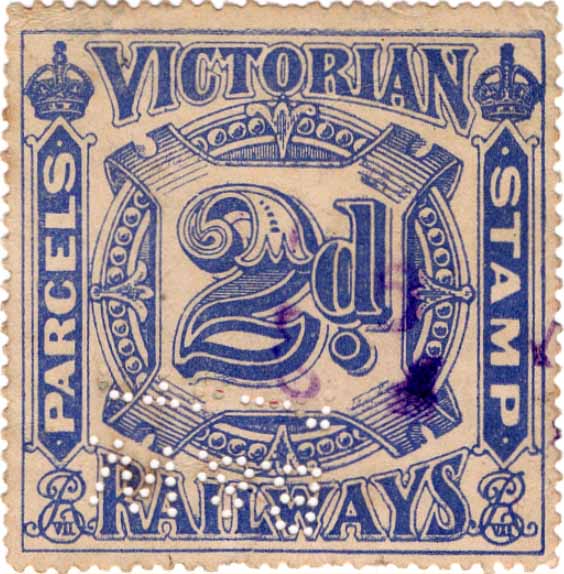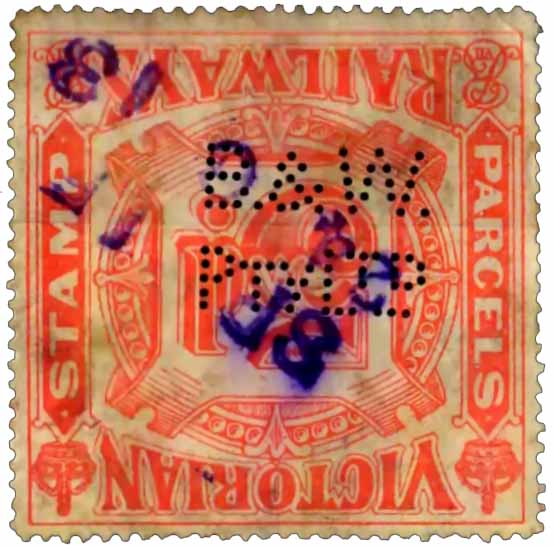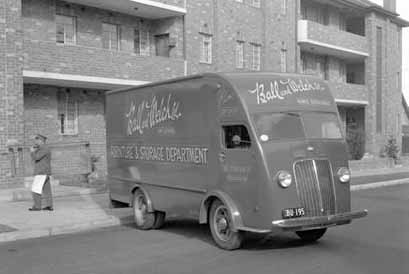|
Private Revenue Perfins of Victoria An Elsmore Coath production The authors would welcome your comments additions or input into this work A B C D E F G H I J K L M N O P Q R S T U V W Y Other B -------------------------------------------------------- B.a
User: Briscoe & Co Wholesale Ironmongers Address: 396 Little Collins St, Melbourne, VIC Revenue Use: 1886-1899 Series, inscribed 'STAMP DUTY' 6d Rarity Scale: 1886-1899 Series 6d R4
Background: *The birth of the Briscoe’s company dates to the eighteenth century. It was probably William Briscoe who established the firm in Wolverhampton, Staffordshire, sometime around 1750. Some reports state a start date of 1756 and others as about 1768. In 1781 members of the Briscoe family formally signed a partnership agreement. The headquarters eventually moved to London, with branches established in the West Indies and South America. A Melbourne offshoot was established in about 1854, and New Zealand operations opened in Dunedin as Arthur Briscoe & Co. in 1863. The founding manager in Dunedin was Hugh MacNeil, who had begun his working life as an ironmonger in Glasgow before managing Briscoes in Melbourne. He became a partner in the firm in 1880 and gained managerial control of both the New Zealand and Australian operations. The company had different names in different parts of the world including: Wm Briscoe & Son (Wolverhampton and London), Briscoe & Co. (Melbourne), Briscoe, Drysdale & Co. (Sydney), Briscoe Bros (Jamaica), and Arthur Briscoe & Co. (Dunedin). In the 1890s branches were established in Wellington and Auckland as Briscoe, MacNeil & Co.
A picture of Briscoe and Co., Ironmongers, Collins Street, which is painted on its side wall ‘Briscoe & Co., General Ironmongers and Iron Merchants’. In March 1912 Briscoe & Co’s premises in Little Collins Street, Melbourne was the centre of an extensive fire which also involved the Stock Exchange, the English Scottish and Australian Bank and the Bank of New South Wales. The total loss was estimated as £40,000. Briscoes’ head office moved from London to Melbourne in 1958, and then to New Zealand in 1970. The parent company was purchased by Merbank Corporation of Australia in 1973 and transformed from a wholesaler of imported goods to a general merchandise retailer. Briscoes Group Ltd was purchased by the R.A. Duke Trust (of New Zealand) in 1990 and became a public company in 2001. As of 2011 it has 54 Homeware stores and 32 Rebel Sport sporting goods stores throughout New Zealand. Device: The B pattern is made from a temporary die in a single die format. Such devices, which could produce these temporary patterns, were used by some Stamp Vendors in Melbourne from late 1800’s and early part of the 20th Century. This particular pattern is known over the period 1896-98. It is most commonly found on postage stamps. These B patterns are found with extra pins that form serifs on the top and bottom of the B. This variation is only reported on postage stamps. Related Patterns: Refer to other Briscoe & Co patterns in: VIC: B.b * auspostalhistory.com David Murray, Archivist at Hocken -------------------------------------------------------- B.b
User: Briscoe & Co Wholesale Ironmongers Address: 396 Little Collins St, Melbourne, VIC Revenue Use: 1886-1899 [1890] Series, inscribed 'STAMP DUTY' 1d Rarity Scale: 1886-1899 [1890] Series 1d R4
Background: See B.a
Device: The B pattern is made from a temporary die in a single die format. Such devices, which could produce these temporary patterns, were used by some Stamp Vendors in Melbourne from late 1800’s and early part of the 20th Century. This particular pattern is known over the period 1897- 1901. It is most commonly found on postage stamps. This is an example of these B patterns being found with extra pins that form serifs on the top and bottom of the B. This B.b is similar to B.a but the scale is slightly smaller. Related Patterns: Refer to other Briscoe & Co patterns in: VIC: B.a -------------------------------------------------------- BB.a
User: Unknown Address: Melbourne, VIC Revenue Use: 1886-1899 Series, inscribed 'STAMP DUTY' 6d Rarity Scale: 1886-1899 Series 6d R4
Background: Unknown
Device: The BB pattern is made from a temporary die in a single die format. This particular pattern is known over the period 1896-1903. It is most commonly found on postage stamps. These BB patterns are found with extra pins that form serifs on the top and bottom of both the B’s. This variation is only reported on postage stamps. Related Patterns: Nil -------------------------------------------------------- B.H/P.a User: The Broken Hill Pty Co Ltd Mining and Steel Making Address: 31 Queen St, Melbourne, VIC Revenue Use: Rarity Scale: Background: *The Broken Hill Proprietary Company Limited, BHP Co. Ltd., was incorporated in 1885 and operated the silver and lead mine at Broken Hill in western News South Wales In 1915, the company ventured into steel manufacturing, with its operations based primarily in Newcastle (NSW). This move was motivated by difficulties in obtaining sustained ore form Broken Hill but this was overcome when the company discovered rich deposits of Iron ore at Iron Knob and Iron Monarch in South Australia as well as new methods of processing tailings from the Broken Hill site. During the 1960’s the company expanded into petroleum exploration, particularly in Bass Strait between Victoria and Tasmania. Later BHP began to diversify into the Ok Tedi copper mine in Papua New Guinea, and later still the Escondida copper mine in Chile and the Ekati diamond mine in northern Canada. The company closed its steel operations in Newcastle in 1999 but continued to be involved in steel production at other sites through its OneSteel operation, which was sold off in 2000. In 2001, BHP merged with the Billiton mining company to form BHP Billiton.
Device: The BH/P.a device is a single die device that is found used on postage stamps of Victoria over the period 1896 until 1901. This is during the Stamp Duty period of Victoria prior to Federation and this pattern is found on these issues including higher values, including the 2/6. Revenue use of such high values is more common than postal use. This may have lead to confusion in the report, stating that it was used as a revenue. All of the examples that we have seen of this pattern are postal usage. Related Patterns: Nil * Wikipedia BHP Billiton web site -------------------------------------------------------- B/McG/McH.a
User: Brooks, McGlashen and McHarg Pty Ltd Softgoods Warehousemen Address: 267-271 Flinders Lane, Melbourne, VIC Revenue Use: 1886-1899 Series, inscribed 'STAMP DUTY' 1d Rarity Scale: 1886-1899 Series 1d R4
Background: There are few records of the company of Brooks, McGlashen and McHarg, which is odd, as they appear to have been a rather large company with who were known in Melbourne from the 1880’s until at least 1955. Furthermore they appear to have had warehouses in regional Victoria (Ballarat) and to have had a shop front in Tasmania (Launceston). They traded in softgoods but with departments dedicated to hats, ribbons, feathers and other finery. In October 1893 that encountered some financial problems and had debts of around £40,000 with creditors, mainly in England. The company made an offer of 15/- in the pound to its creditors and this was accepted. The company became a limited liability company and this may have been at this time. In February 1900 the companies building in Flinders Lane was destroyed by fire with damages estimated to be £25,000. The fire was intense and at one stage threatened the warehouse of Paterson, Laing, and Bruce which was located across the street. The building had been rebuilt following an earlier fire 1897. One of the company’s principals Mr. Andrew McHarg, died in Melbourne in October 1941, aged 78. The company was deregistered in 1961.
Device: The B/McG/McH.a pattern is made from a temporary die in a single die format. This pattern is known over the period 1898-99. It is most commonly found on postage stamps. Related Patterns: Refer to other Brooks, McGlashen and McHarg patterns in: VIC: B/McG/McH.b, B/MG/MH.a -------------------------------------------------------- B/McG/McH.b
User: Brooks, McGlashen and McHarg Pty Ltd Softgoods Warehousemen Address: 267-271 Flinders Lane, Melbourne, VIC Revenue Use: 1886-1899 Series, inscribed 'STAMP DUTY' 2d Rarity Scale: 1886-1899 Series 2d R4
Background: See B/McG/McH.a Device: Device: The B/MG/MH.b pattern is made from a temporary die in a single die format. This pattern is known to have been used in 1899. It is most commonly found on postage stamps. Related Patterns: Refer to other Brooks, McGlashen and McHarg patterns in: VIC: B/McG/McH.a, B/MG/MH.a -------------------------------------------------------- B/MG/MH.a
User: Brooks, McGlashen and McHarg Softgoods Warehousemen Address: 267-271 Flinders Lane, Melbourne, VIC Revenue Use: 1886-1899 Series, inscribed 'STAMP DUTY' 6d Rarity Scale: 1886-1899 Series 6d R4
Background: See B/McG/McH.a Device: Device: The B/MG/MH.a pattern is made from a temporary die in a single die format. This pattern is known to have been used in 1899. It is most commonly found on postage stamps. Related Patterns: Refer to other Brooks, McGlashen and McHarg patterns in: VIC: B/McG/McH.a, B/McG/McH.b -------------------------------------------------------- BN.a
User: Buckley & Nunn Drapers - Later Department Store Address: 300-310 Bourke St, Melbourne, VIC Revenue Use: 1915 Series: 2d Rarity Scale:
1915 Series 2d R4 Background: Buckley & Nunn was co-founded by Mars Buckley born c1825 In Mallow, County Cork, Ireland, and his partner, Crumpton John Nunn born 1828. Buckley emigrated to Victoria in 1851 with his wife, Elizabeth Maroon, née Neville, and their child. He arrived with goods to sell at the Ballarat and Forest Creek goldfields, which proved profitable. On the arrival of another consignment of goods in 1852 he began business in partnership with English-born Nunn as Buckley & Nunn. Nunn soon returned to England to manage the purchasing side of the business. Buckley & Nunn's first store was a drapery store but later they secured land in Bourke Street frontage of 27 ft (8.2 m), which was later extended to 162 ft (49 m) with a depth of 300 ft (91 m). In 1860s the company established direct communications with the main British suppliers and the store made annual profits of about £40,000. In 1866 Buckley helped to found the Commercial Bank of Australia. After the death of Nunn by suicide in 1891, Buckley sold the business to Robert Reid, who later sold it on in London in 1892 for £300,000. The business was now called Buckley & Nunn Pty Ltd. Buckley hated publicity and took no part in political or municipal life. Buckley died at his home in Toorak, of heart failure at the age of 80, on 9 October 1905. He was survived by his wife and five of their seven children. The business was made into a public company Buckley & Nunn Ltd, which modernized the business and built the two iconic buildings on the north side of Bourke Street, the western building in 1911-12 and the eastern building in 1933-34. The business and properties were bought by David Jones in 1982, and merged into the David Jones group. The company was delisted from the ASX on 5 May 1982. Device: The BN pattern is made from a temporary die in a single die format. Such devices, which could produce these temporary patterns, were used by some Stamp Vendors in Melbourne from late 1800’s and early part of the 20th Century. This particular BN pattern is known to have been used over the period 1911-20. It is most commonly found on postage stamps. These temporary BN and B&N patterns are found over periods in which the company owned a customised perforating device, B&N.d. It is possible that the single die B&N.d was either at a different location or could not meet the demand for the puncturing of stamps. The BN and B&N devices found used on revenue stamps were used in the following periods: BN.a 1911-1920 BN.b 1920-1924 B&N.a 1894-1909 B&N.b 1897-1902 B&N.c 1908-1912 B&N.d 1905-1946 Related Patterns: Refer to other Buckley & Nunn patterns in: VIC: BN.b, B&N.a, B&N.b, B&N.c, B&N.d -------------------------------------------------------- BN.b
User: Buckley & Nunn Drapers - Later Department Store Address: 300-310 Bourke St, Melbourne, VIC Revenue Use: 1915 Series: 2d Rarity Scale:
1915 Series 2d R4
Background: See BN.a Device: The BN pattern is made from a temporary die in a single die format. This particular BN pattern is known to have been used over the period 1920-24. It is most commonly found on postage stamps. See also BN.a Related Patterns: Refer to other Buckley & Nunn patterns in: VIC: BN.a, B&N.a, B&N.b, B&N.c, B&N.d -------------------------------------------------------- B&N.a
User: Buckley & Nunn Drapers - Later Department Store Address: 300-310 Bourke St, Melbourne, VIC Revenue Use: 1886-1899 Series, inscribed 'STAMP DUTY' 1d (shades) Rarity Scale:
1886-1899 Series 1d R4
Background: See BN.a Device: The B&N pattern is made from a temporary die in a single die format. This particular B&N pattern is known to have been used over the period 1894-1909. It is most commonly found on postage stamps. See also BN.a Related Patterns: Refer to other Buckley & Nunn patterns in: VIC: BN.a, BN.b, B&N.b, B&N.c, B&N.d -------------------------------------------------------- B&N.b
User: Buckley & Nunn Drapers - Later Department Store Address: 300-310 Bourke St, Melbourne, VIC Revenue Use: 1911 Series 1d Rarity Scale:
1911 Series 1d R4
Background: See BN.a Device: The B&N pattern is made from a temporary die in a single die format. This particular B&N pattern is known to have been used over the period 1897-1902. It is most commonly found on postage stamps. See also BN.a Related Patterns: Refer to other Buckley & Nunn patterns in: VIC: BN.a, BN.b, B&N.a, B&N.c, B&N.d -------------------------------------------------------- B&N.c
User: Buckley & Nunn Drapers - Later Department Store Address: 300-310 Bourke St, Melbourne, VIC Revenue Use: 1911 Series 1d Rarity Scale:
1911 Series 1d R4
Background: See BN.a Device: The B&N pattern is made from a temporary die in a single die format. This particular B&N pattern is known to have been used over the period 1908-1912. It is most commonly found on postage stamps. See also BN.a Related Patterns: Refer to other Buckley & Nunn patterns in: VIC: BN.A, BN.b, B&N.a, B&N.b, B&N.d -------------------------------------------------------- B&N.d
User: Buckley & Nunn Drapers - Later Department Store Address: 300-310 Bourke St, Melbourne, VIC Revenue Use: 1915 Series: 2d Rarity Scale:
1915 Series 2d R4
Background: See BN.a Device: This was the first customised device purchased by the company and it was in a single die format. It was in service between 1905-1946. See also BN.a Related Patterns: Refer to other Buckley & Nunn patterns in: VIC: BN.a, BN.b, B&N.a, B&N.b, B&N.c ------------------------------------------------------- BR/&Co.a
User: Brooks Robinson & Co Oil & Colour Merchants Address: 59-65 Elizabeth St, Melbourne, VIC Revenue Use: 1886-1899 Series, inscribed 'STAMP DUTY' 1d (shades) Rarity Scale:
1886-1899 Series 1d R4
Background: *The company of that became Brooks, Robinson & Co. began in 1854 as import agents, dealing in window and table glass, interior-decorating supplies such as paints and wallpaper and later tiles and grates. The company initially traded as Henry Brooks & Co. under the management of Brooks who had arrived in Melbourne in 1852. The company later moved into commercial glazing, particularly shopfronts, but did not produce the stained-glass windows; it would become famous for, until the 1880s. The company made some small stained glass windows in the 1880’s but there big opportunity came in the 1890s when they were engaged to install St Paul's Cathedral's great cycle of stained-glass windows, made by Clayton & Bell in London. From this time the company’s stained-glass studio flourished, and after the closure of their major competitor Ferguson & Urie in 1899, Brooks, Robinson & Co attained a dominant position in the trade. The company recruited glass artists and related trades from England and also almost all the Australian glass artists of the early 20th century passed through their studio. Their work is represented in the Princess Theatre and St John's, Toorak and hundreds of other locations around Melbourne and Victoria. They built a new building in 1910 which was located at 59-65 Elizabeth Street Melbourne. This new building was built at the same address where Brooks Robinson & Co had been for many decades prior. During the construction they traded from premises they acquired in 1909 in Maffra Street, South Melbourne. The company continued to trade through the 20th Century but the stained-glass studio closed after Brooks Robinson was taken over by Email Pty Ltd in 1963.
Device: The BR/&Co.a device was the most advanced perfin device of its time used in Melbourne. The device was a multi die device of at least 6 dies in a 3 wide by 2 high layout. It was possibly larger. The device was in service from 1893 until at least 1920 and it is very common on postage stamps but rare on revenues. Related Patterns: Nil * emelbourne.net.au Trove -------------------------------------------------------- BS/&Co.a
User: Beath, Schiess & Co (later Ltd) Later Beath, Schiess & Felstead Ltd Warehousers later Clothing Manufacturers Address: Flinders Lane, Melbourne, VIC Revenue Use: 1886-1899 Series, inscribed 'STAMP DUTY' 1d (shades) Rarity Scale:
1886-1899 Series 1d R4 Background: *David Beath was born in 1835 at Leslie, Fifeshire, Scotland. At the age of 14 years he went to Edinburgh and entered the service of Messrs. Murray and Logan, with the intention to study law. However in 1853, due to poor health, he decided to take abandon law and he took a commercial position in the leading business house in Manchester. He then took an opportunity to come to Australia, where he landed in September 1858. He initially had a business partnership in Geelong but after 6 months he moved to Melbourne with the intention of setting up in business on his own account. He lived first in Fitzroy Street, St. Kilda, and in later years used to tell how he walked to the city each morning, scrambling over gullies on the way. He was employed by Messrs. Langlands, Buick, and Co. warehousers and later drapers, which in 1861 was divided up with Beath and two partners taking over one portion, which became known as Pyne, Harrison, Beath, & Co. Within two years the company had branches in Christchurch and Dunedin in New Zealand, but this expansion the New Zealand company was in turn divided off with the Melbourne company becoming Pyne, Beath, and Co. In 1868 Mr Schiess arrived from England to join the company, and later with the death of Mr Pyne the company was renamed Beath, Schiess, and Co. Later in about 1909 Mr. Felstead joined the company, which was then reorganised as a limited company in 1912. In 1863 Mr. Beath married Miss Bowden of Barwon Banks, Geelong and they had 5 children, 4 daughters and a son. Beath was actively involved in the Anglican Church and was associated with the Young Men's Christian Association (YMCA) and later was the co founder, with Sir Matthew Davies, of the Boys' Brigade. He was one of the first chairmen of the Royal Bank, trustee of the Savings Bank, and with James Munro he established the Victoria Coffee Palace and the Grand Hotel, in Spring street, now known as the Hotel Windsor. David Beath died in 1915 but the company continued to trade. From 1932 the company traded in liquidation.
The company had many warehouses and production facilities around Melbourne and was know for disagreements with seamstresses and allied trades over issues of work rates and terms and conditions in the early days of unionised labour in the 1880’s and 1890’s. Device: The company were heavy Perfin users over the period 1895-1920, and they owned a series of refurbished devices but they also purchased perfined stamps from Stamp Vendors with temporary Perfins such as BS/&Co.a. Although there are about 40 distinct patterns in the BS&CO, BSF and BS&F layouts attributable to Beath, Schiess & Co or Beath, Schiess, and Felstead Ltd, only this BS/&Co.a is reported on revenue stamps. Related Patterns: BS/&Co.b *Trove -------------------------------------------------------- BS/&Co.b
User: Beath, Schiess & Co (later Ltd) Later Beath, Schiess & Felstead Ltd Warehousers later Clothing Manufacturers Address: Flinders Lane, Melbourne, VIC Revenue Use: 1886-1899 Series, inscribed 'STAMP DUTY' 1d (shades) Rarity Scale:
1886-1899 Series 1d R4 Background: See BS/&Co.a Device: See BS/&Co.a. The BS/&Co.b pattern was also a Temporary pattern. It is similar to BS/&Co.a but has a different shaped C. It is a one off setting and it is only found in 1902. Related Patterns:BS&/Co.a -------------------------------------------------------- BT/&Co.a
User: Bernie Teare & Co Engineers and Machinery Agents Address: 61-69 A'Beckett St, Melbourne, VIC Revenue Use: 1886-1899 Series, inscribed 'STAMP DUTY' 1d (shades) Rarity Scale:
1886-1899 Series 1d R4
Background: Bennie, Teare, and Co, were the sole representatives of the English Engineering company of Tangyes Limited, a large engineering company that manufactured farming, industrial and mining equipment. Tangyes Limited had been started by Richard Tangye in Birmingham in 1856 as a hardware factor and commission agent. Tangyes Limited grew rapidly and by the early 1870’s it had a workforce of over 2000 and had expanded to have sales offices across the British Empire, including Australia and New Zealand. Following the Depression in Australia of the 1880’s, Tangyes Limited closed there Melbourne branch in 1894 and the Sydney branch in 1896. The agency for the whole continent was then assigned to Bennie, Teare & Co. William Bennie was a Scottish immigrant who had been a partner in the Scottish Iron Merchants and Nail makers, David Bennie and Sons until 1884; he had established Bennie, Teare & Co about 1888. The company had established a large factory, which was totally destroyed by fire in 1895. Device: The BT/&Co.a pattern is made from a temporary die in a single die format. This pattern is known to have been used over the period 1895-96. It is most commonly found on postage stamps. Related Patterns: Nil *Trove Paperspast -------------------------------------------------------- B.&W./PTYLTD.a
User: Ball & Welch Pty Ltd Drapers Address: 180 Flinders St, Melbourne, VIC Railway Use: 1902
Issue 2d, 5d, 6d, 1/- 1917 Wing issue 1d, 2d, 5d, 7d, 8d, 9d, 10d Railway Scale:
1902
Issue 2d R4, 5d R4, 6d R4, 1/- R4
1917 Wing issue 1d R4, 2d R4, 5d R4, 7d R4, 8d R4, 9d R4, 10d R4 Background: Ball & Welch Pty Ltd. Became a prominent Department store in Melbourne from 1899 until the 1970s. The company was founded as a drapery business in the 1850’s by Charles Ball (born Frome, Somerset, England) and his nephew W H Welch. The company’s first stores opened on The Goldfields at Forest Creek, at Vaughan Springs (near Castlemaine, Victoria) in 1861 and they later opened another store at Castlemaine in 1882. In 1874 they opened a large store in the Melbourne inner suburb of Carlton. The large three-storied premises had frontages to Faraday, Drummond and Swanston streets. Eventually an emporium at 180-188 Flinders Street was designed by architects Reed Smart & Tappin and was completed in 1899 in an American Romanesque style. It was extended in 1911 with the purchase of the adjoining Commercial Travellers’ Club. The store occupied around one third of the total block and stretched between Flinders Street and Flinders Lane. The Carlton premises were subsequently used as a warehouse, and this site was the subject of a major fire in 1928. The company opened a Sydney that operated between 1913 and 1924, and the Castlemaine store was finally closed in 1941. With suburban retail expansion in the 1960s, branches were opened in Frankston, Camberwell, and at the Eastland and Southland shopping centres. In its heyday, the Ball & Welch department store was Melbourne’s leading family draper, it’s A to Z departments including gloves, umbrellas and handkerchiefs, mantles, furniture, mercery, millinery, furs and corsets. At one time 26 assistants were devoted to the sale of lace alone. The upmarket department store company Georges Australia Ltd bought Ball & Welch in 1970, closing the stores in 1976 because of declining profits. The Flinders Street store was renovated as Flinders Fair shopping centre in the late 1970s, its façade (including the Commercial Travellers’ Club frontage) were eventually incorporated into the Flindersgate car park building that is located at 172-192 Flinders St, Melbourne.
Ball and Welch delivery van circa 1940. Device: This B.&W./PTYLTD.a pattern is made from a single die customised device that was only used on Victorian Railway stamps and only in the period 1902 until 1917. Single die Related Patterns: Nil -------------------------------------------------------- A B C D E F G H I J K L M N O P Q R S T U V W Y Other © copyright 2011 |

